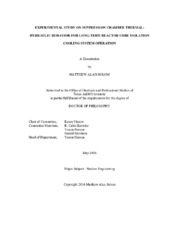| dc.description.abstract | In current Station Blackout analyses for Generation II Light Water Reactors, battery failure in 4-8 hours is expected to result in the failure of the Reactor Core Isolation Cooling System. The RCIC System, which uses a steam-turbine driven pump to pump cooling water to the reactor, theoretically requires DC power for the controller to operate. However, in the Fukushima Daiichi accidents at Units 2 and 3, the RCIC System performed for much longer than expected. It managed to continue working long after the loss of critical DC power, even without operator intervention.
In order to better understand the RCIC System and Suppression Pool in long-term system operation, a model of the system was constructed at the Laboratory for Nuclear Heat Transfer Systems at Texas A&M University. This experiment investigated the thermal hydraulic limitations of the RCIC System, focusing on the Suppression Pool. In 32 individual tests, several parameters were varied; these included the steam flow rate, the steam quality, the sparger design, and the pressure conditions in the Suppression Chamber.
It was found that the Suppression Pool, with a strong dependence on conditions, can experience a great deal of thermal stratification resulting from RCIC System operations. Such stratification can be both beneficial and limiting; pump suction from the bottom of the pool will be cooler when stratified, protecting the pump, while at the same time containment pressurization will be accelerated. Chugging at the beginning and bubbling later on tended to enhance pool mixing while calm conditions in the intermediate period tended towards stratification. A chugging correlation has been adapted and modified to describe the state of mixing in the scaled pool.
The SRV-analog tests had little to no effective thermal stratification in the Suppression Chamber, whereas every RCIC-analog test had some. Pressure in the Suppression Chamber in particular was strongly associated with the degree of stratification; one pressurized case had >65 °C of thermal separation, while a similar but fully-vented atmospheric case saw only 13 °C. While steam quality and steam flowrate affected the thermal stratification, their effects were neither as pronounced nor as simple as those of the pressurization conditions. | en |


